 |
||
|
||
| ||
Perhaps the IT industry has never experienced such impetuous and mass buoyancy in modern history, of which the PC cooling systems sector can boast today. Almost every single day the arsenals of cooler-manufacturing grandees are replenished with new high-technology ammunition – solid, impressive, and certainly with some innovation spirit. You are sometimes amazed at what the Oriental craftsmen can do with their products, it's breath taking! But there seems to be no other easier way: state-of-the-art heated processors make inexorable demands to cooling system characteristics and dictate new game rules. These game rules are considerably different from those that were in force in this sphere just 2-3 years ago. As a result, the "standard" technologies of cooler manufacturing very often turn out ineffective to solve the current tactical tasks. And you cannot count on grandiose success without introducing promising designs (together with deploying corresponding engineering processes). Meanwhile, along with a considerable positive portion brought by the advanced technologies, their dark side also has its effect – low economical efficiency of the over-featured cooling systems and their carnivorous treatment of customer budgets. It sometimes runs into absurdity: prices of some extra refined cooling devices are on the par or even higher than those for decently featured computers! Just imagine! What about those users who do not waste their money right and left and who do not want to participate in this "arms race"?! The economical new coolers adequate to the task are getting increasingly rare to appear on the market, while "rock monsters" radiating stunning (and financially unjustified) technical health are increasing in geometric progression sucking a flow of banknotes out of customers' wallets like spaghetti. Not an attractive picture, is it? However that may be, low end coolers are still holding their positions – they hold the fort like heroes despite the heavy onset of the enemy. Today, the AMD Athlon 64 "foe" will meet our advanced reconnaissance detachment: three low-end coolers – GlacialTech of the Igloo 7200 series, as well as Speeze DolphinReef and Titan TTC-K8ATB/825/SC. Let's see how they will cope with their mission! GlacialTech Igloo 7200 Light, Igloo 7200 and Igloo 7200 ProNew products in the GlacialTech series – Igloo 7200 Light, Igloo 7200 and Igloo 7200 Pro coolers – are based on a single-type aluminium 78x70x42 mm heatsink (78x67 mm base) equipped with 80x80x18 mm fans (we are already familiar with these Everflow R128018DL, R128018DM and R128018DH models), which are traditionally ranked by their fan speed (nominal 1900, 2400 and 3200 rpm correspondingly). 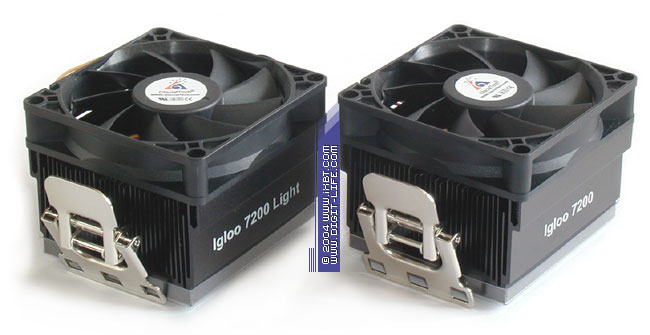 In spite of their simple design, "modest" Igloo 7200 coolers are not devoid of internal technical grace. We can again note well-established thermal efficiency catalysts peculiar to the Igloo series – tapered section fins (0.7 mm thick at the base and 0.3 mm at the point) and fin height alternation. Another thermal aid in stock of Igloo 7200 is the wavy bulges in the heatsink base, which serve to reduce the negative effect of resistance to the spreading of the heat flow and to increase the efficiency of peripheral finning. 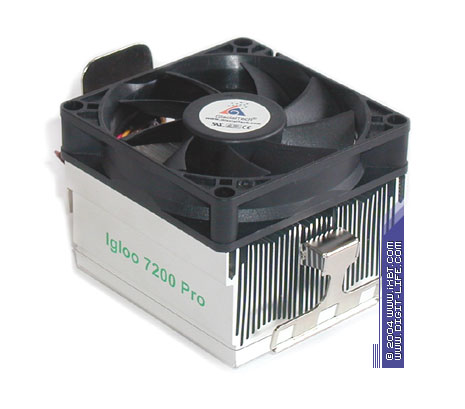 The mounting system of these coolers also produces a good impression – it's remarkable for a friendly construction (piece-of-cake ideology) and it demonstrates strictly standard clip force providing quick and neat placement of the heatsink into the socket. Additional installation advantage of Igloo 7200 is the new highly efficient thermal paste (its filling agent is an aluminium oxide and aluminium nitride compound) possessing improved thermal characteristics. You can hardly overestimate this issue: with the area of thermal contact between the heatsink and the CPU we have in Athlon 64, the contribution of the thermal interface into the overall thermal resistance of a cooler can make up dozens of percents. So the role of the thermal paste quality is getting quite considerable here. 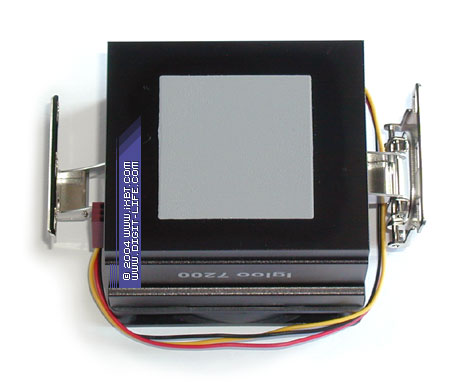 With this fairly good thermal equipment, Igloo 7200 does not lose a chance to display its warcraft and fortitude. Thus, the slow-speed Igloo 7200 Light easily outscores its "boxed" colleague (Ajigo MF043-044) and fairs on the par with the loud all-copper Thermaltake Venus 8+ cooler while demonstrating a really ergonomic noise level. The remarkable efficiency is also displayed by Igloo 7200 – it manages "to bring to grass" worthy thermal efficiency and reconcile it with humane noise ergonomics (by its efficiency/noise ratio this cooler is only slightly outscored by high end Zalman CNPS7000A-AlCu and Gigabyte 3D Cooler-Ultra operating in noiseless modes). And "master sergeant" Igloo 7200 Pro almost manages to square the circle – by its thermal characteristics it comes close to such cooling colossi as Zalman CNPS7000A-Cu and Thermaltake Silent Tower, and it keeps strictly within the bounds of noise decency. Well, in actual fact Igloo 7200 "soldiers" demonstrate quite interesting functionality, they cope well with their tasks, and though they belong to the low end class, they do not hesitate to get close on the heels of their high end pals. Those coolers prove again that you can achieve much, if you approach the engineering process with proper skill and put technical characteristics of the cooler on the top of the list, not just surface embellishments spiced up with copper and noisy fans. Unfortunately, far from all cooler manufacturers stick to this ideology. That's their mistake! Speeze DolphinReefThe next in our battle array is the low end Speeze DolphinReef, the only cooler for Socket 754/939 currently produced by this company. DolphinReef is based on the aluminium 77x68x38 mm heatsink, spiced with a 70x70x15 mm fan (Fanner Tech FD07015B1H, 4200 rpm) and equipped with additional installation facilities – retention module for Socket 754/939 and a standard supporting plate. 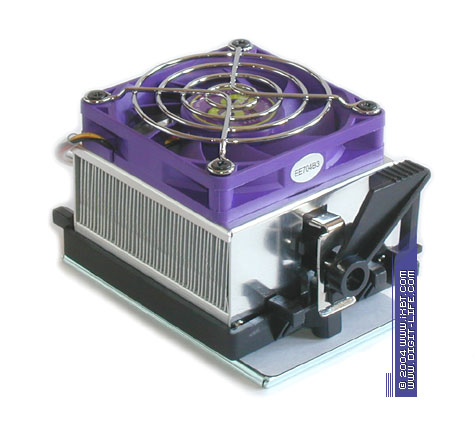 The cooler is based on the reference design recommended by AMD (Thermal Reference Design Solution 2, which is thoroughly copied by the "boxed" Ajigo MF043-044), but Speeze limits itself to an all-aluminium solution instead of a combined copper-aluminium heatsink. However, this heatsink is not at all less interesting and, being manufactured according to the advanced skived fin technology, it demonstrates fairly good finning parameters (0.3 mm thick fins at 1.5 mm step, total heat-transfer area is about 1200 cm2). To all appearances, it has some chances to demonstrate fair thermal efficiency. The retention system of DolphinReef also looks quite decent, inheriting reference features of the AMD design: the cooler can be installed quickly and simply. However, this retention module can hardly be called ergonomic in fact – in comparison with a much friendlier and more convenient retention module of GlacialTech Igloo 7200 or, say, Gigabyte 3D Cooler-Ultra it still leaves much to be desired. Additional installation devices produce an ambiguous impression as well: they are obviously not for free, but they are practically useless for a common user, because both retention module and the supporting plate are almost always included into the bundles of Socket 754/939 mainboards. For such a low-budget cooler as DolphinReef, it's all nothing but needless luxury. But as you know, thermal efficiency cannot be redundant. Considering that DolphinReef has no special problems with it: the cooler is not at all embarrassed by its all-aluminium nature and outscores its "boxed" colleague (obviously due to its optimized "turned" finning, which is more thermally and hydraulically effective than the dense soldered finning of Ajigo MF043-044). But this efficiency comes at a dear cost – our "daredevil" is let down by a noisy high-speed fan, which noticeably clouds the overall functionality of DolphinReef. As a result, it does not allow it to become a truly attractive low end cooler. Titan TTC-K8ATB/825/SCA low end representative of Titan products ("mighty" TTC-K8ATB/825/SC) brings up the rear. This cooler is based on an aluminium 77x82x40 mm heatsink (77x68 mm base), it's equipped with an 80x80x25 mm fan (Titan TFD-8025SH12C, nominal fan speed – 3800 rpm) and comes shipped with a fan speed control, allowing to vary the speed from 1800 to 3800 rpm, as well as additional retention devices. 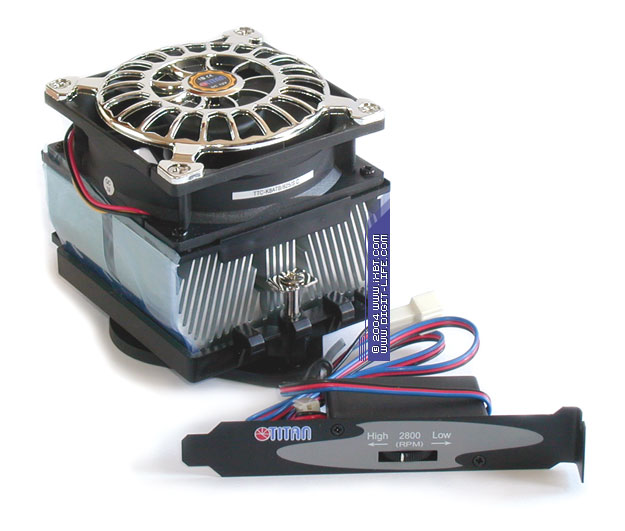 TTC-K8ATB/825/SC looks not bad – at first sight the enlarged heatsink and full-sized fan seem like a promising duet. But a closer examination ruins this soft and pleasing impression to be replaced by disappointment. To put it mildly, the main reason is a funny finning configuration demonstrated by TTC-K8ATB/825/SC: instead of a well-set rectangular plate construction, Titan engineers decided to tilt the peripheral finning at a small angle to the heatsink center. Their considerations are beyond us, this fin placement imminently increasing the hydraulic resistance of the heatsink, considerably weakening its blow-through capacity and drastically reducing the effective heat dissipating area (the volume provided by this heatsink could have offered much more developed finning, at least 1.5-2 times as large area). Mystery of the century! The copper 77x38x3 mm plate press-fit into the base does not inspire optimism either: it will hardly be able to develop good symbiosis with the thermally weakened heatsink. 
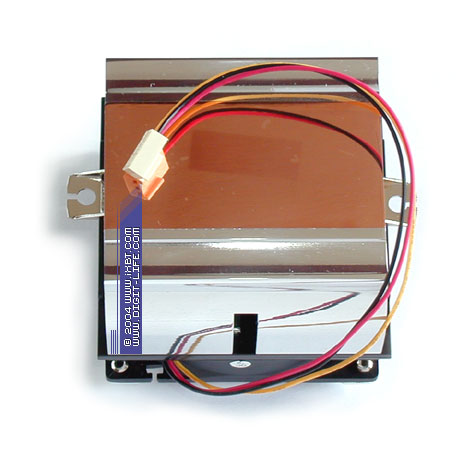 Well, in actual fact it is true. TTC-K8ATB/825/SC demonstrates results interesting to the slightest extent only in the low-speed mode (1800 rpm) – low thermal efficiency is compensated here by the pleasant noise ergonomics. At the average speed (2800 rpm) it still reveals thermal weakness, but the noise level increases considerably. And at maximum speed (3800 rpm) the situation gets completely out of hand: the cooler achieves only negligible improvement of thermal characteristics, but the cost is a very loud noise crossing the "red line" of 50 dBA. In the final analysis it strongly disparages the image of TTC-K8ATB/825/SC. By the whole complex of technical characteristics (where the inconvenient retention module also pours oil on the flame) this cooler is outscored by its low end colleagues GlacialTech Igloo 7200 and Speeze DolphinReef. Engineers from Titan have a lot of issues to improve! What concerns us, it's high time to proceed to the substantial results of our today's "reconnaissance in force". Test resultsLet's start with the results of the thermal efficiency analysis of our coolers under review. Testbed configuration 1:
To emulate the thermal load we use the burnk7 utility from CPUBurn. System Guard from Fijitsu Siemens Computers is used to control the temperatures. Here is what the test results look like: Diagram 1. Temperature readings Notes Diagram 2. Thermal resistance
And finally, here are the results of noise measurements (to learn about this method, read the article "Noise characteristics of coolers and methods of measuring noise levels"). Diagram 3. Noise characteristics
To all appearances, no comments are necessary. Let's draw the bottom line! ConclusionsPerhaps the main result of our tests is the fact that AMD Athlon 64 processors, despite the common opinion, are not so hot tempered to be chilled down by the most state-of-the-art cooling systems: these days even top Athlon 64 models are quite favourable to low end coolers. It's not meant as a reproach to Intel Pentium 4, but they are quite comfortable with low end cooling than the latter processors. What concerns the subjects of our analysis, today we want to note particularly the new Igloo 7200 series of coolers from GlacialTech, which prove themselves the best. They combine high thermal efficiency with pleasing noise ergonomics, and by the whole complex of features they are sure leaders among the products of their class. The other two coolers – Speeze DolphinReef and Titan TTC-K8ATB/825/SC – act with varying success and reveal a number of technical flaws. Nevertheless, these coolers will also manage to provide admissible thermal conditions both for low end and top AMD Athlon 64 processors.
Write a comment below. No registration needed!
|
Platform · Video · Multimedia · Mobile · Other || About us & Privacy policy · Twitter · Facebook Copyright © Byrds Research & Publishing, Ltd., 1997–2011. All rights reserved. |